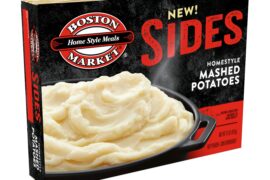Frozen product innovations very much figure into the top five food trends that Arlington, Virginia-headquartered Nestlé USA is watching closely in 2019, based on insights gleaned recently from a commissioned market research survey of 2,200 consumers conducted nationwide by Morning Consult.
“The prepared and frozen foods of the 1990s are child’s play compared with the wide-ranging cuisines available now. Our research on today’s trends shows that 70 percent of people cook at home using a combination of homemade and prepared dishes,” said Chairman and CEO Steve Presley. “Frozen and prepared foods invite more people to inject creativity into their meal plans and make culinary discovery a part of their lives. More than four in five people agree that combining homemade and prepared dishes allows them to experience new or different flavors, and the same percentage of respondents likes trying new foods.”
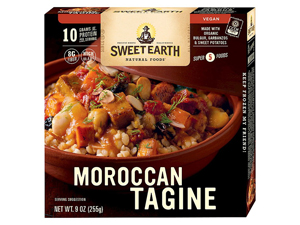 Nestlé USA, which rang up $9.7 billion in sales during 2017, is obliging those willing to venture out. Its Sweet Earth brand, for example, offers a vegetarian Moroccan Tagine – a hearty stew featuring the flavors and spices of North Africa, garbanzo beans, sweet potatoes, red peppers, curry seitan, bulgur, almonds, raisins, cinnamon and cloves.
Nestlé USA, which rang up $9.7 billion in sales during 2017, is obliging those willing to venture out. Its Sweet Earth brand, for example, offers a vegetarian Moroccan Tagine – a hearty stew featuring the flavors and spices of North Africa, garbanzo beans, sweet potatoes, red peppers, curry seitan, bulgur, almonds, raisins, cinnamon and cloves.
Nestlé acquired Sweet Earth, a plant-based foods manufacturer based in Moss Landing, California, in September of 2017. The acquisition gave it immediate entry into the plant-based foods segment, which is growing by double digits and expected to become a $5 billion market by 2020.
Sweet Earth’s portfolio spans all meal occasions, diversifying Nestlé’s offering beyond its existing category leadership in meals and snacks. The product line ranges from award-winning frozen meals, burritos and breakfast sandwiches to chilled plant-based burgers and proteins sold in more than 10,000 stores across North America – including independent natural grocers, Whole Foods, Target, Kroger and Walmart.
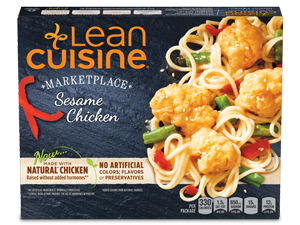 “And our Lean Cuisine Sesame Chicken combines sesame breaded white meat chicken with pasta, cut green beans, red peppers, and a savory plum sauce,” remarked Presley. “We are committed as a business to this category of food, which brings value and convenience to consumers and offers something special to your daily menu.”
“And our Lean Cuisine Sesame Chicken combines sesame breaded white meat chicken with pasta, cut green beans, red peppers, and a savory plum sauce,” remarked Presley. “We are committed as a business to this category of food, which brings value and convenience to consumers and offers something special to your daily menu.”
A Matter of Taste
Taste will continue to be #1 in driving consumer choices, even as other priorities grow.
“Consumers today have a growing interest in convenience, and they’ve never been more aware of the nutritional value and sourcing of the foods they eat,” said the chief executive officer. “Yet our survey confirmed what many of you surely know through your daily lives: Taste matters most. Even as we’re balancing other priorities like nutrition and convenience, taste does not get compromised — we should be able to have it all.”
When considering snacks to eat, for instance, 93 percent of respondents said flavor was most important.
“As a food company, we know this better than anyone, and we’re continuing to hold ourselves to higher and higher bars on taste” said Presley.
“We all enjoy a variety of foods and snacks, and though we strive for healthy eating, we are not bound by the binary choice of taste or nutrition. Sure, you can enjoy a pint of Häagen-Dazs Trio Vanilla Blackberry Chocolate ice cream as an indulgence, but our Coffee-Mate Natural Bliss Honey shows how exceptional taste can arrive with less added sugar, too.”
The Buzz About Coffee
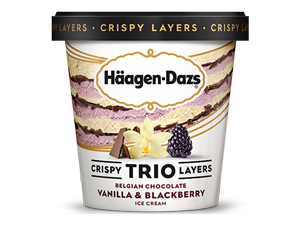 The subject of coffee, needless to say, perks up the maker of popular Nescafé, Nespresso, Starbucks, Blue Bottle and Chameleon beverage brands.
The subject of coffee, needless to say, perks up the maker of popular Nescafé, Nespresso, Starbucks, Blue Bottle and Chameleon beverage brands.
“Innovation in coffee will be one of the trends we’ll be driving in 2019, and our survey shows that people are ready for new things,” said Nestlé USA’s chief executive officer. “More than one in three consumers have tried or were planning to try on-the-go bottled coffee drinks, and on-the-move consumers tend to trend younger, with more than half of Gen Z trying bottled coffee drinks in 2018 or planning to in 2019. With new launches like the Nescafé Coffee Protein Smoothie and Cold Whipped Latte, this category will be percolating with innovation in 2019.”
E-Commerce and Delivery Trends
As the changing retail landscape and escalation of e-commerce continue to upend the old models of consumer behavior, Nestlé is growing quickly in this space and investing in the innovations that will shape purchasing in 2019 and the years that follow.
“We have been working closely with retailers on the in-store experience and click-and-collect models, and in 2018 Nestlé USA’s e-business sales grew at twice the rate of the industry,” reported Presley. “Virtual reality grocery shopping, for instance, very well may shape the future of retail, and it’s a future that Nestlé will help build, investing in growth-enabling e-commerce capabilities across the business.
The Morning Consult survey illuminated how some of the shopping trends are changing consumers, and Nestlé expects this to continue on an upward trajectory in 2019. Though more than three-quarters of Americans go to the grocery store as their main way of buying food, about one in five either get food purchases delivered at least once a week or order groceries online for pickup. An interesting nugget in the data: men are nearly twice as likely as women to favor online or delivery as an option.
Game Changers
Climate and sustainability will remain game-changers for younger consumers.
“Nestlé is a leader in big and small ways in how we source our ingredients and make the changes that can change our industry to address issues that are important to our consumers,” said Presley. “We won’t be able to connect with consumers on the impact of the food system, unless we do it through their lens, including around critical areas that impact their health and safety like climate change.”
More than half of respondents (54 percent) said they have altered their eating or food purchasing habits because of climate change concerns. The younger generations, in particular, are on the watch and tuned in to what companies like Nestlé are doing. Generation Z is three times as likely as Baby Boomers are to report changing their eating behaviors due to climate change.
Farm-wind expansion last spring at Nestlé factories in Pennsylvania has boosted production with renewable energy that will reduce greenhouse gas emissions. The company has enhanced its plant-based food portfolio with Sweet Earth, as these foods can be produced with a reduced carbon impact. And Nestlé Waters installed a third wind turbine at a bottling facility in Cabazon, California, putting it on target to be 100 percent of our electricity from renewable energy.
“As a company and as people, we have an enormous stake in what happens to the planet. And though we’ve been around for more than 150 years, we need a healthy planet and healthy people to keep creating exciting new products for the next 150 years,” said Presley.
A year ago, Chief Strategy Officer Rui Barbas laid out the case for innovation at Nestlé amid what he called the most dramatic market shifts of the past 10 to 15 years – “from consumer habits, behavior, and engagement with brands to how goods are purchased.”
“To hyper-focus on our consumer, our business is changing,” said Presley. “We’re driving a hybrid growth model, accelerating brands that are classic favorites as well as new investments, and shifting our culture to move with agility and take more risks. You can already see our growth in the market stemming from those changes, with brands like Häagen-Dazs, Coffee-mate and Outshine.”
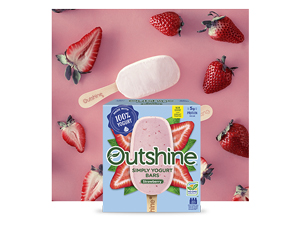 The chief executive officer concluded: “From what we’re hearing from consumers today, 2019 will be another year of disruption, creation, innovation, and excitement in the food landscape. Consumers can change as quickly as they want, and we make it our mission to adapt to meet their every need. One food trend of 2019 that I can be certain of: whatever consumers demand in the year ahead, Nestlé will be ready to deliver.”
The chief executive officer concluded: “From what we’re hearing from consumers today, 2019 will be another year of disruption, creation, innovation, and excitement in the food landscape. Consumers can change as quickly as they want, and we make it our mission to adapt to meet their every need. One food trend of 2019 that I can be certain of: whatever consumers demand in the year ahead, Nestlé will be ready to deliver.”




